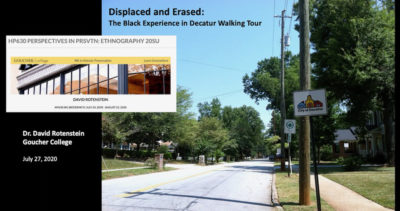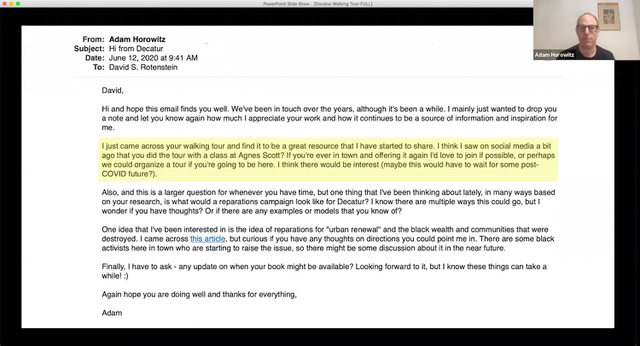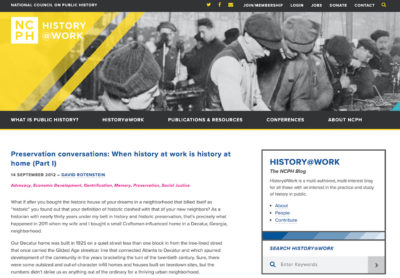A Virtual Walking Tour in Decatur, Georgia: Linking Race, History, Community
10 September 2020 – David Rotenstein
public engagement, community history, digital history, sense of place, collaboration, race, walking tours, covid-19, teaching public history

Image from the virtual walking tour given by David Rotenstein on July 27, 2020. Screenshot courtesy of David Rotenstein.
I teach a seminar on ethnography and community engagement in Goucher College’s graduate historic preservation program. Last year, I took my students to Baltimore’s Otterbein neighborhood, a historic district and one of the nation’s earliest urban homesteading neighborhoods.[i] The COVID-19 pandemic pushed our summer term online and that meant no class field trip to Baltimore, an annual program tradition. While I had initially planned a virtual trip to Otterbein, an email from a Decatur, Georgia, resident upended those plans; instead, my students would visit Decatur in a community engagement exercise played out on Zoom in real-time.
Map of the Displaced and Erased walking tour planned for the National Council on Public History 2020 Annual Meeting by David Rotenstein. Image courtesy of the author.
The class tour reprised a walking tour I had designed for the 2020 NCPH Annual Meeting in Atlanta . When the in-person conference became a virtual one, I re-engineered the tour for Zoom using a PowerPoint deck that I had created for a February 2020 visit to Decatur’s Agnes Scott College. History professor Robin Morris had invited me to take her public history students on a tour test run. To compensate for potential inclement weather, I had converted much of the tour into an illustrated PowerPoint presentation that followed the sequence of “stops” throughout downtown Decatur and the Black communities that had been erased by slum clearance and urban renewal. I selected photos taken during my research in the city between 2011 and 2018. That PowerPoint deck became the foundation for the NCPH tour and then for the class tour.
Decatur resident Adam Horowitz had seen my social media posts about the tour and emailed me in June to ask about it. “Just came across your walking tour and find it to be a great resource that I have started to share,” he wrote in the email. “If you’re ever in town and offering it again I’d love to join if possible, or perhaps we could organize a tour if you’re going to be here.”

Email from Adam Horowitz to David Rotenstein, June 12, 2020. Screenshot courtesy of the author.
Over the next four weeks, Adam and I coordinated our parallel efforts via Zoom and email. In an interview after the tour, he explained to me what he wanted to accomplish and how the tour fit with his anti-racism activism in Decatur.
“One of the needs right now is to sort of build our capacity as activists and change agents in Decatur and I think one of the things that we need to do that is to better understand the context that we’re engaged in,” Adam wrote. “I think the tour is an excellent way to do that, in a relatively easy digestible format.”

First blog post about Decatur written by David Rotenstein in 2012. Screenshot courtesy of History@Work.
Decatur is a familiar site to History@Work readers. In August 2012 I first wrote about my research on gentrification and erasure there. Over the next several years, History@Work published posts about the city’s racially biased historic preservation efforts, racial profiling by police, community responses to gentrification, and a comparison to Apartheid-era South Africa. It’s a city with deep structural racism issues that have evolved and intensified over more than a century.[ii]
Offering the tour to Adam and his collaborators and neighbors and using it as a real-world engagement opportunity for my students seemed like a perfect pedagogical opportunity for everyone. It would meet Adam’s objectives to broaden Decaturites’ horizons and expose them to history that has been erased and forgotten locally. In my course, students learn to apply ethnographic tools while engaging with the people who live in the communities where they are doing historic preservation work. This virtual field work would also give them a chance to see how the class readings and lectures were relevant outside the classroom (or, in our case, the Zoom grid).
I designed the Goucher seminar in 2019 to combine some of the experience I had gained from 35 years in public history and cultural resource management with my work in communities experiencing displacement, gentrification, and erasure. I wanted to teach students how to weave collaboration and consultation through all phases of their historic preservation work, from project design to the days and years that follow turning in the final survey reports and historic property designation forms.[iii]
Adam used Facebook groups and personal connections to invite members of his social justice activism network. I maintained the Google Forms registration and sent links and reminders to everyone who registered. I also provided my students with readings on Decatur, which we discussed in a Zoom session the day before the virtual tour.
I made some adjustments to the tour that I gave to NCPH participants in March. A lot had changed in the four months since the inaugural tour. Nationally, communities were taking to the streets protesting police violence in the wake of George Floyd’s murder in May. And Confederate monuments and memorials dedicated to colonizers and enslavers were falling across the continent and in Europe. In Decatur, workers removed the long-contested Confederate monument erected in 1908. A county judge ordered it removed after three years of protests by social justice activists. Acting to fulfill the judge’s order, heavy machinery removed the obelisk and its pedestal overnight before Juneteenth.[iv] My script and slides needed an update.
The revised script included embedding audio clips from the interviews that I had done with Decatur residents since 2011, as well as a new video clip. The tour followed the same route through downtown as the NCPH version, and there were opportunities for Decaturites and Goucher students to comment and ask questions at each of the “stops.”
The day of the tour, 62 Decatur residents had registered; about 30 actually participated, along with my students and a handful of Goucher faculty colleagues. Historic Preservation program director Melanie Lytle invited the entire Goucher historic preservation community.
“Our annual Residency is the most important time of the year in the Goucher low-residency MAHP program,” Lytle wrote to me after I asked for her feedback on the tour. “I was delighted to make Dr. Rotenstein’s virtual walking tour an all-program activity so that students would not miss out on the [unusual] opportunity to participate in a community engagement activity while at Residency.”
Lytle also reflected on how the tour fit into Goucher’s approach to teaching historic preservation: “It was a chance to see Dr. Rotenstein model interaction with community members. I see potential in this format for students to go beyond observing to practicing community interaction for themselves.”
My class objectives were met. But what about Adam’s goals? “I’ll characterize them as positive responses even though … some people were upset,” Adam said. Many people he knew, especially white Decatur transplants, had heard the city’s branding as a liberal and progressive place. Decatur’s unofficial motto for the past 20 years has been “Where Mayberry meets Berkeley.”
The tour, Adam explained, dismantles that image: “Hearing this sort of the myth about Decatur and buying into it. And so just kind of feeling this—I mean it’s some kind of combination of sort of anger, sadness, embarrassment around our culpability in how this story continues to play out.”
My work toward completing a book on erasure and gentrification continues. Adam and I will continue to collaborate as he develops a curriculum for anti-racism activists that includes a strong history component that tells Decatur’s full story. “I do think that is the history that really grounds the organization and I think it’s the most effective way I can think of to share it,” he said.
~David Rotenstein is a public historian and folklorist based in Pittsburgh.
[i] Otterbein has much in common with Decatur, a point I made during the tour introduction. In October 2011, I watched a local builder demolish one of Decatur’s urban homesteading properties. My research into that teardown led to the project to understand and document gentrification and erasure in Decatur. See David S. Rotenstein, “Reviving South Decatur Through Urban Homesteading,” Times of DeKalb, DeKalb History Center newsletter 6, no. 2 (Spring 2012), 1, 4–5; Rotenstein, David S. “The Decatur Plan: Folklore, Historic Preservation, and the Black Experience in Gentrifying Spaces,” The Journal of American Folklore 132, no. 526 (2019), 431–51.
[ii] David S. Rotenstein, “Why Diversity Initiatives Rarely Make Gentrifying Neighborhoods More Equitable,” Next City (blog), September 14, 2017, https://nextcity.org/daily/entry/decatur-georgia-diversity-initiatives-fail-gentrification-equity.
[iii] I described the circumstances pivotal in my decision to pitch a new course to Goucher in this History@Work post, David S. Rotenstein, “Competing Histories or Hidden Transcripts? The Sources We Use.” History@Work (blog), March 13, 2019, https://ncph.org/history-at-work/hidden-transcripts-sources-we-use/.
[iv] The protests and demands to remove the monument began after white supremacist violence in Charlottesville, Virginia in 2017 spurred a nationwide movement. Georgia state law blocked efforts by the municipal and county governments to move the monument. Mark Niesse and Tia Mitchell, “Confederate Monument in Decatur Can Be Moved but Not Concealed,” Atlanta Journal-Constitution, December 5, 2017;, Tia Mitchell, “DeKalb Ready to Accept Proposals to Move Confederate Monument.” Atlanta Journal-Constitution, January 23, 2018.



